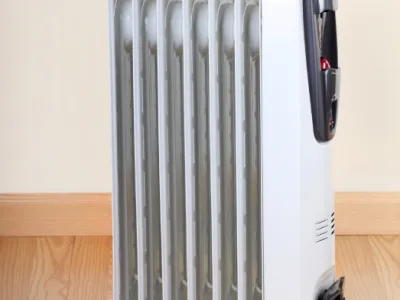Managing space heater usage

Published December 29, 2020
As we enter the winter months, temperatures are starting to drop, and many households may be looking to portable space heaters to help stay warm in their homes. If this includes you, it is important to factor in the capability, costs, and efficiency of space heaters. This blog post will dig into the costs of using space heaters and discuss other effective ways to stay warm.
Portable electric space heaters can help boost the temperature of a room that does not have adequate heat or create extra warmth for someone who is especially sensitive to colder temperatures, such as a baby or an elderly family member. According to the US Department of Energy, space heaters typically operate through convection, circulating warm air through a room to raise its temperature.
Though space heaters can be very effective in heating smaller spaces, electric costs can quickly add up. An average space heater’s power ranges between 750-1500 watts, meaning that using a single space heater for 8 hours a day could cost around $20-$40 in a single month. Thermostatically-controlled space heaters, which allow you to set the unit to your desired room temperature, are less likely to waste energy by overheating a room and so can cost less to operate, but they still consume a large amount of energy.
When using space heaters, it is also crucial to pay attention to the heater’s safety features, so as to prevent any fire hazards or risk of burn. Space heaters are to blame for 25,000 home fires and send 6,000 people to the emergency room for burns each year. To use space heaters safely, place the heater on a flat and stable surface, at least three feet away from any potentially combustible materials (e.g. curtains, papers, clothes, or furniture), water, or flammable liquids. It’s also important to plug space heaters directly into the wall socket, rather than using extension cords or power strips, and make sure that there are no signs of fraying or other damage on the cord. For more safety tips for space heater usage, check out this post from Beltrami Electric Cooperative.
Beyond using space heaters, there are also many other ways to stay warm at home and minimize your heating bills, especially as winter temperatures continue to drop. When dressing in layers is not enough, an electric blanket can be a less costly option. Electric blankets’ power demand varies but is often around 60 watts — just 8-16 percent of what a space heater uses. Covering up cracks where air escapes from your home is a great method of ensuring the warmth from your heating system does not end up leaking outside, especially if you live in an older home constructed earlier than the 1980s. Some simple air sealing will more than pay for itself in many homes. For more winter energy saving tips, check out this blog post!
As always, if you are struggling to pay your utility bills or are looking for ways to save energy in your home, contact CUB to learn about eligibility for energy assistance programs or to schedule a free 30-minute bill consultation.